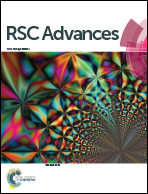Solar light driven dye degradation using novel organo–inorganic (6,13-pentacenequinone/TiO2) nanocomposite†
Abstract
The coupled semiconductor photocatalysts of 6,13-pentacenequinone/TiO2 (PQ/Ti) with different weight ratios were prepared. The PQ/TiO2 nanocomposite was prepared by a simple wet impregnation method. The prepared catalyst was characterized with various spectroscopic methods. XRD confirms the monoclinic and anatase phase of PQ and TiO2, respectively. FE-SEM showed the sheet like morphology of PQ, whereas the coupled catalyst depicts the formation of a homogeneous layer of TiO2 on the PQ surface in all three compositions. Optical studies by diffuse reflectance UV-Visible absorbance spectroscopy (DRS) indicate the band gap of PQ and TiO2 around 2.8 and 3.2 eV respectively. The absorbance in the range of 450 nm was also observed in the case of the prepared coupled catalyst confirming the loading of PQ on TiO2. The photocatalytic activity of the coupled catalyst was studied by observing the degradation of methylene blue (MB) dye under visible light irradiation. As compare to the individual components, the coupled organo–inorganic catalyst showed higher photocatalytic activity towards MB degradation. The PQ/TiO2 nanocomposite having 0.2 wt% PQ showed the highest rate of MB degradation i.e. Kapp = 5.2 × 10−2 min−1.


 Please wait while we load your content...
Please wait while we load your content...